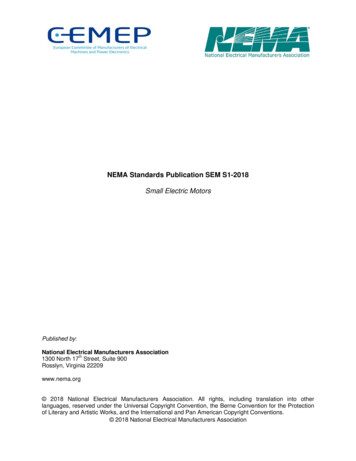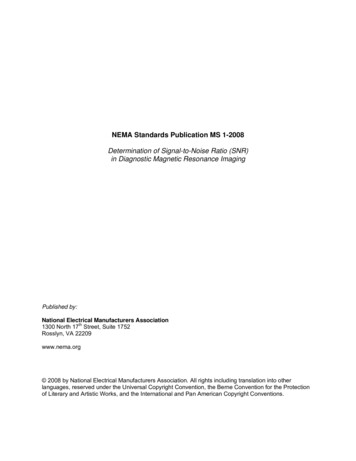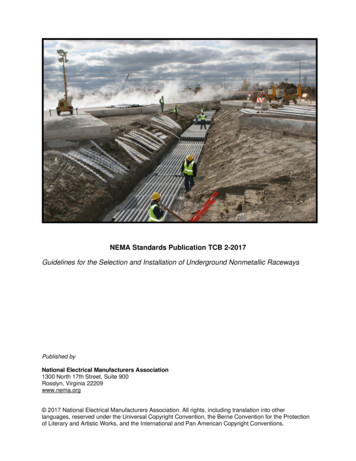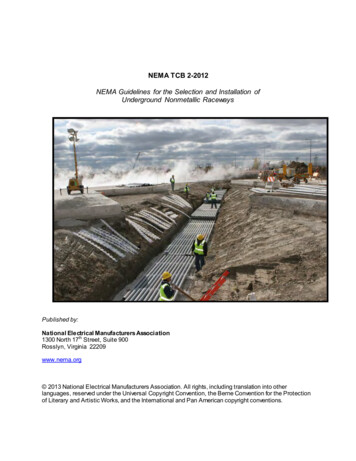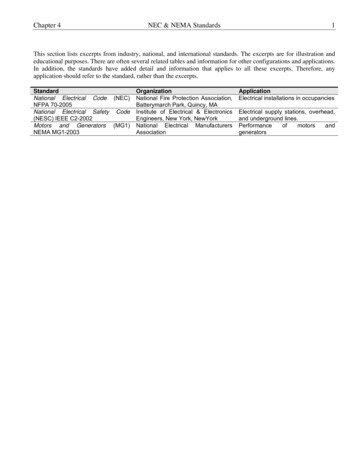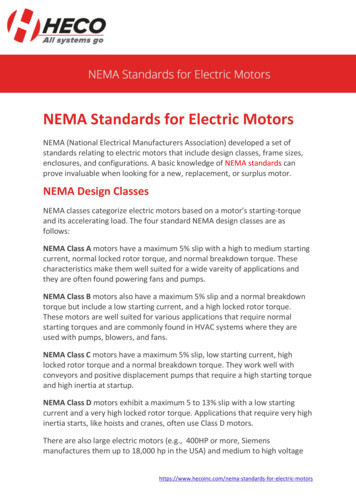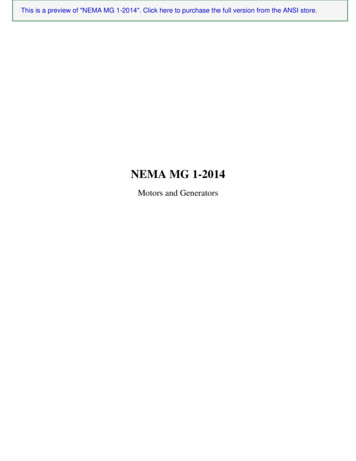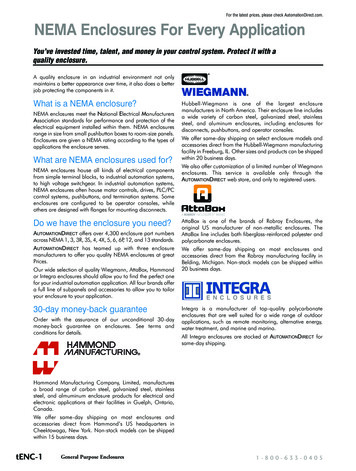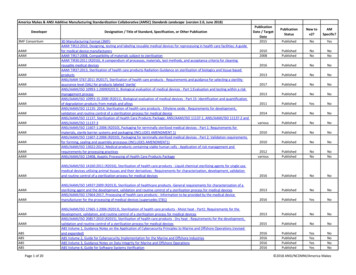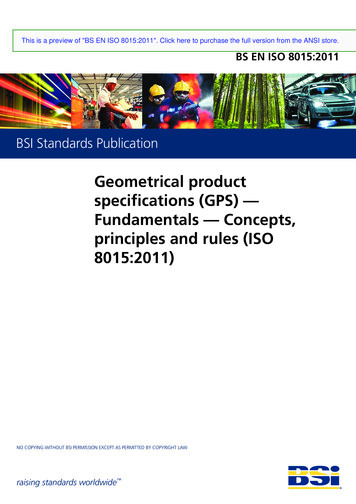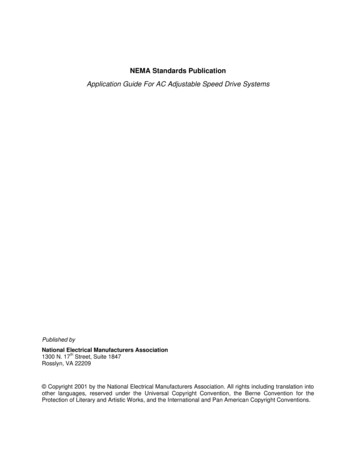
Transcription
NEMA Standards PublicationApplication Guide For AC Adjustable Speed Drive SystemsPublished byNational Electrical Manufacturers Associationth1300 N. 17 Street, Suite 1847Rosslyn, VA 22209 Copyright 2001 by the National Electrical Manufacturers Association. All rights including translation intoother languages, reserved under the Universal Copyright Convention, the Berne Convention for theProtection of Literary and Artistic Works, and the International and Pan American Copyright Conventions.
NOTICE AND DISCLAIMERThe information in this publication was considered technically sound by the consensus of personsengaged in the development and approval of the document at the time it was developed.Consensus does not necessarily mean that there is unanimous agreement among every personparticipating in the development of this document.NEMA standards and guideline publications, of which the document contained herein is one,are developed through a voluntary consensus standards development process. This processbrings together volunteers and/or seeks out the views of persons who have an interest in thetopic covered by this publication. While NEMA administers the process and establishes rulesto promote fairness in the development of consensus, it does not write the document and itdoes not independently test, evaluate, or verify the accuracy or completeness of anyinformation or the soundness of any judgments contained in its standards and guidelinepublications.NEMA disclaims liability for any personal injury, property, or other damages of any naturewhatsoever, whether special, indirect, consequential, or compensatory, directly or indirectlyresulting from the publication, use of, application, or reliance on this document. NEMAdisclaims and makes no guaranty or warranty, express or implied, as to the accuracy orcompleteness of any information published herein, and disclaims and makes no warranty thatthe information in this document will fulfill any of your particular purposes or needs. NEMAdoes not undertake to guarantee the performance of any individual manufacturer or seller’sproducts or services by virtue of this standard or guide.In publishing and making this document available, NEMA is not undertaking to renderprofessional or other services for or on behalf of any person or entity, nor is NEMA undertakingto perform any duty owed by any person or entity to someone else. Anyone using thisdocument should rely on his or her own independent judgment or, as appropriate, seek theadvice of a competent professional in determining the exercise of reasonable care in any givencircumstances. Information and other standards on the topic covered by this publication maybe available from other sources, which the user may wish to consult for additional views orinformation not covered by this publication.NEMA has no power, nor does it undertake to police or enforce compliance with the contentsof this document. NEMA does not certify, test, or inspect products, designs, or installations forsafety or health purposes. Any certification or other statement of compliance with any healthor safety–related information in this document shall not be attributable to NEMA and is solelythe responsibility of the certifier or maker of the statement.
TABLE OF CONTENTS1. SCOPE.12. REFERENCED STANDARDS .12.1 REFERENCED NEMA STANDARDS .12.1.1 MG1-1998 Motors and Generators . 12.1.2 ICS 7 -1993 Industrial Control and Systems Adjustable-Speed Drives. 12.1.3 ICS 7.1-1995 Safety Standards for Construction and Guide for Selection, Installation, and Operationof Adjustable Speed Drive Systems. 12.1.4 NEMA 250-1996 Enclosures for Electrical Equipment (1000 Volts Maximum) . 12.2 OTHER REFERENCED STANDARDS .23. DEFINITIONS.24. DESCRIPTION OF SYSTEM COMPONENTS .54.1 LOAD TYPES .54.1.1 Variable torque. 54.1.2 Constant Torque . 64.1.3 Constant horsepower . 84.2 MOTOR TYPES .94.2.1 General . 94.2.2 Design A. 94.2.3 Design B. 104.2.4 Design C . 104.2.5 Design D . 104.2.6 Definite-Purpose Inverter-Fed . 114.3 CONTROL TYPES .124.3.1 Typical Power Ratings . 124.3.2 Control Methods . 124.3.3 PWM Modulation Techniques . 135. DESCRIPTION OF COMPONENT INTERACTIONS .145.1 INTERACTION BETWEEN LOAD AND MOTOR .145.1.1 Service Factor. 145.1.2 Maximum safe operating speed. 145.1.3 Overspeed Capability . 145.1.4 Direction of Rotation . 165.2 INTERACTION BETWEEN MOTOR AND CONTROL.175.2.1 Thermal Considerations . 175.2.2 Power Factor Correction. 225.2.3 Speed range . 225.2.4 Acceleration Time. 235.2.5 Deceleration Time / Internal Motor Braking . 245.2.6 Reversal. 25
5.2.7 Stability. 255.2.8 Bypass . 255.2.9 Motor Terminal Voltage Transients . 265.2.10 Shaft Voltage and Bearing Currents. 325.2.11 Load Reactors and Filters . 375.2.12 Multiple Motors. 375.2.13 Pole Count . 385.2.14 Connecting High Voltage to the Low Voltage Connection of a Dual Voltage General-Purpose Motor385.3 INTERACTION BETWEEN CONTROL AND AC POWER LINE .395.3.1 Source Impedance/Short-circuit Ampere Interrupting Capacity (AIC) Ratings . 395.3.2 Line Variations . 405.3.3 AC Line Power Factor. 405.3.4 Line Harmonic Currents – Adjustable Frequency Control Created . 415.3.5 Control Protection . 425.4 DRIVE SYSTEM INTERACTIONS .445.4.1 Efficiency. 445.4.2 Sound, Vibration, Resonance. 445.4.3 Grounding . 455.4.4 Power Cable Selection . 465.4.5 Electromagnetic Compatibility (EMC) . 496. SELECTION OF MOTOR AND CONTROL BY APPLICATION .506.1 APPLICATION INFORMATION .506.2 MOTOR SELECTION .516.2.1 Determine Motor Enclosure Requirements. 516.2.2 Determine Motor Torque and Speed Requirements . 516.2.3 Determine Accelerating and Decelerating Requirements (Time and Load) . 526.2.4 Overload. 536.2.5 Determine Type of Duty. 536.2.6 Other Considerations. 546.3 CONTROL SELECTION.556.3.1 Control Type Considerations . 556.3.2 Control and Motor Voltage Considerations . 556.3.3 Control HP/Current Rating Considerations . 566.3.4 Control Enclosure Considerations. 566.3.5 Speed Range and Regulation Considerations.
NEMA standards and guideline publications, of which the document contained herein is one, are developed through a voluntary consensus standards dev elopment process. This process brings together volunteers and/or seeks out the views of persons who have an interest in the topic covered by this publication. While NEMA administers the process and establishes rules to promote fairness in the .
